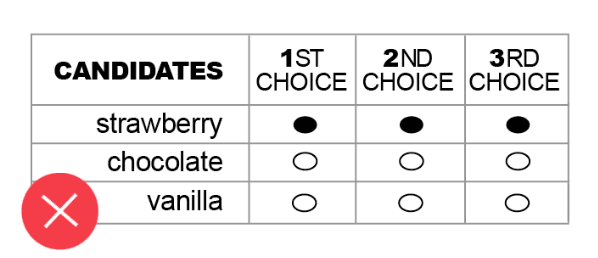Translations of this information is available in the following languages:
Arabic | العربية - Burmese | မြန်မာစာ - French | Français - Nepali | नेपाली - Somali | Soomaali - Swahili | Kiswahili
What is Ranked Choice Voting?
Ranked-choice voting (RCV) is an election method that allows voters the option to rank candidates in order of preference (first choice, second choice, third choice, and so on). Ranking candidates is different from simply selecting one candidate or what is known as plurality voting. If a candidate receives more than 50% of the first choices, that candidate wins, just like in any other election. However, if there is no majority winner after counting the first choices, the race is decided by an instant runoff. The candidate with the fewest votes is eliminated, and voters who ranked that candidate as their first choice will have their votes count for their next choice. This process continues until only two candidates remain; the remaining candidate with the greatest number of votes is elected.
For a visual on how votes are counted in rounds, visit NYC Votes.
Why are we using Ranked Choice Voting?
In March 2021, Burlington residents voted to implement Ranked Choice Voting for City Councilors. It passed with 64% support. In March 2023, Burlington residents voted to expand Ranked Choice Voting in city elections, to include races for Mayor, City Councilors, School Commissioners, Ward Clerks, and Inspectors of Election. This passed with 64% support.
Which Elections will use Ranked Choice Voting?
Burlington will use Ranked Choice voting for the following city officials: Mayor, City Councilors, School Commissioners, Ward Clerks, and Inspectors of Election.
How do I mark my ballot?
With Ranked Choice Voting, voters mark their ballots in order of preference – 1st choice, 2nd choice, 3rd choice, and so on.
1. Select a first-choice candidate by completely filling in the oval next to the candidate’s name in the FIRST CHOICE column.
2. If you have a second-choice candidate, completely fill in the oval next to that candidate’s name in the SECOND CHOICE column.
3. If you have a third-choice candidate, completely fill in the oval next to that candidate’s name in the THIRD CHOICE column.
4. You can continue to rank candidates until you run out of allowable rankings or run out of candidates.
Important points about correctly marking a Ranked Choice Voting ballot:
- Mark only one choice per column.
- Mark only one choice per candidate.
- Do not skip rankings. For example, do not fill in 1st and 3rd choices without filling out a 2nd choice.
- You may rank as few candidates as you would like.
- You may rank as many candidates as are allowed.
EXAMPLES:
EXAMPLE 1:
Correctly marked ballot, on which voter has indicated a 1st, 2nd, and 3rd choice.

EXAMPLE 2:
Overvoted 2nd ranking where 1st choice is marked correctly, two candidates are marked for 2nd choice, 3rd choice is not marked.
How this voter’s ballot will be counted:
- The first choice will be counted.
- The second choice vote will not be counted – voter’s intent cannot be determined because this column has been overvoted.

EXAMPLE 3:
Duplicate ranking where the same candidate is marked for 1st, 2nd, and 3rd choices.
How this voter’s ballot will be counted:
- The first choice will be counted.
- If the first-choice candidate is eliminated, the second and third choices cannot be considered, as they are duplications.

Resource: Ranked Choice Voting Resource Center, https://www.rcvresources.org/.